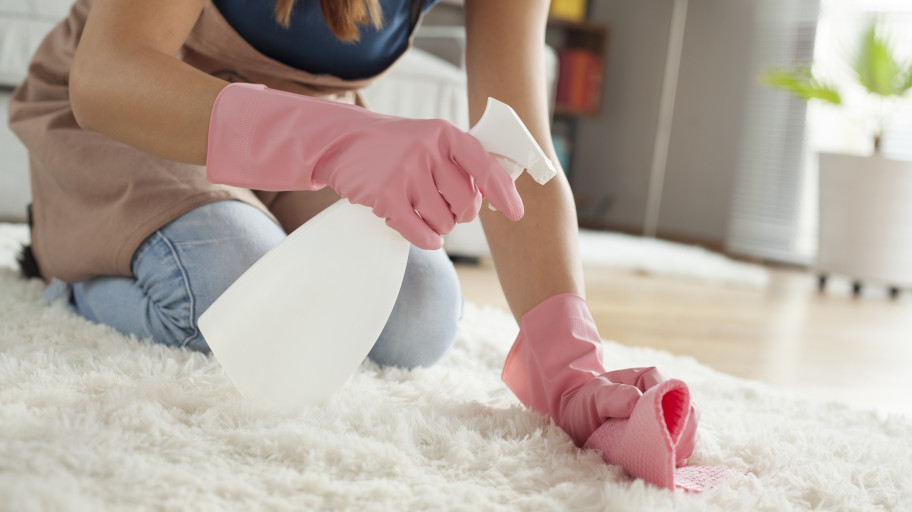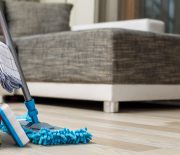Last update: 4 months ago

Carpet is more than just a floor covering. It’s the silent creator of character, warmth, and cosiness at home. Its presence goes beyond mere functionality, transforming a house into a home by creating a unique and inviting ambiance. The texture underfoot, the colour palette, and the overall feel of the carpet contribute to the personality of each room.
Its true beauty shines when it’s clean, but beyond the appearance, it plays an essential role in maintaining a healthier and longer-lasting indoor environment. Carpets and rugs, if not properly cleaned, can harbour dust mites, allergens, and bacteria, posing potential health risks to occupants. Regular carpet cleaning not only preserves the visual allure but also safeguards the well-being of those who call your home, well, home.
Moreover, a clean carpet is an investment in longevity. Although truly deep cleaning is best achieved with a machine and carpet shampoo, there are alternative ways to keep your rugs spotless. This guide will provide effective manual carpet-cleaning techniques on how to clean carpet without a machine to remove nasty carpet stains and unpleasant smells.
Pre-cleaning and spot-testing
When it comes to re-cleaning and spot-testing your carpets, a thorough and careful approach is key. Begin by preparing your rug for non-mechanical cleansing, which involves clearing the area by removing furniture and diligently vacuuming with a regular vacuum or brush.
Pet owners can first remove pet hair with a rubber squeegee. This tool, designed to be both soft and firm-bristled, effectively removes dust, dirt, hair, and other contaminants from carpets. Its wide and narrow structure allows it to effortlessly navigate corners, reach under furniture, and access hard-to-reach spots. Simply water the squeegee, and it’ll collect all the fur, then throw it in the garbage. You can divide the carpet into a few areas and move from the centre towards the edges. It’s a technique used by our Australian-based carpet cleaning company to save time and effort. Alternatively, if a squeegee isn’t on hand, dampened rubber gloves can be used. Wipe the carpets with your hands to gather pet hair from your furry friend’s favourite spots where they sit and sleep.
Looking for expert carpet cleaning services?
Book Fantastic Cleaners!
At the end of the pre-cleaning process, make sure there’s no loose dirt, hair, or debris on the carpet. Before applying any cleaning solution, it’s crucial to spot-test the carpet cleaner in a small area, whether homemade or purchased. This measure helps avoid potential damage to your carpet and ensures that the cleaning solution is compatible with the specific fibres and dyes of your rug.
Before diving into the cleaning process, always prioritise checking the manufacturer’s recommendations for carpet care. Manufacturers often provide specific guidelines for cleaning and maintenance tailored to their products.
Cleaning the carpet by hand
Hiring a professional carpet cleaner or renting a cleaning machine for every carpet cleaning need may not be financially feasible for many. Thus, knowing how to clean a carpet without a carpet cleaner becomes a highly practical skill, especially in households with pets, kids, or a combination of both. This blog article delivers valuable insights into various DIY cleaning methods that are not just effective but are also environmentally friendly.
DIY Cleaning Solutions
Say goodbye to chemical carpet cleaners and embrace the power of do-it-yourself solutions to keep your carpets clean and fresh. You can make effective and natural carpet cleaning solutions using simple pantry ingredients. Check out these easy recipes and techniques for natural carpet cleaning and have a healthier living environment.
- Baking soda carpet cleaner – Sprinkle some baking soda evenly over your carpet. You can add a few drops of essential oil of your choice to have a pleasant smell. Let it sit for 15-30 minutes, then vacuum thoroughly. Your carpets will be naturally refreshed and deodorised.
- Vinegar and water spot cleaner – Mix equal parts white vinegar and water in a spray bottle. Spray the solution directly onto stains or high-traffic areas. Blot the affected area gently with a clean cloth, working from the outside in. This DIY spot cleaner effectively lifts stains without leaving behind any residue.
- Hydrogen peroxide stain remover – Add equal parts hydrogen peroxide and water. Apply the solution directly to the stain and allow it to stay for about 10 minutes, then blot it with a clean cloth. This solution is particularly effective for removing tough stains like coffee or wine.
- Cornstarch and borax carpet powder – Combine equal parts baking soda and cornstarch, add a few drops of essential oil, and sprinkle the mixture over the carpet. Try to vacuum thoroughly to avoid any residue. Your carpets will be rejuvenated and clean.
- Club soda for spills – In case of spills or stains, pour club soda directly onto the affected area. Blot with a clean cloth or paper towel to absorb the liquid. The carbonation in club soda helps lift the stain without damaging the carpet fibres.
- Detergent carpet cleaner – Mix one teaspoon of translucent liquid dishwashing detergent into 1 cup of lukewarm water. You can use laundry detergent without strong additives, bleach, or brighteners. Harsh chemicals in some detergents may damage the carpet fibres or cause discolouration.
Natural carpet cleaning and homemade stain removal have never been easier, and you’ll be pleasantly surprised by the results that rival or even surpass commercial cleaners. Make the switch to DIY cleaning and enjoy a fresh, chemical-free home, regardless of whether you have a carpet cleaner or not.
Spot Cleaning Stains
Carpets often face a range of challenges, with stains, from mud to red wine, easily finding their way onto the floor. So cleaning carpet stains as fast as possible is a crucial aspect of maintenance. Become acquainted with the various types of carpet stains and their removal methods. That said, the most common types of carpet stains are:
- Pet accidents – Pet accidents typically involve urine, faeces, or vomit, which can lead to unpleasant odours and stains. Removal method – Blot the stain with paper towels or a clean cloth to absorb as much liquid as possible. Use a DIY carpet cleaner to break down and neutralise the stain and odour.
- Stains and spills – These can vary widely, including food spills, coffee, tea, juice, and other liquids. Removal method – Act quickly to blot the stain with a clean cloth or paper towels. Combine water and mild detergent for cleaning. Avoid rubbing the stain, as it may spread.
- Red wine – Red wine stains are notorious for their deep colour and potential to set quickly.
Removal method – Blot the stain immediately with a clean, dry cloth. Mix a solution of water and laundry detergent without bleach in it, or white vinegar, and gently dab the stain. Avoid using hot water, as it can cause the stain to become ingrained. - Mould and moisture – Mould stains can occur in damp or humid environments, often as a result of water damage or prolonged exposure to moisture.
Removal method – Address the source of moisture first to prevent further mould growth. Use a solution of water and white vinegar or hydrogen peroxide to clean. Ensure thorough drying to prevent the return of mould. - Cigarette smoke – Over time, carpets can absorb and retain odours from cigarette smoke, leaving a lingering smell.
Removal method – Vacuum the carpet thoroughly to remove surface particles. Use baking soda or specialised carpet deodorisers to neutralise odours. In severe cases, professional steam cleaning may be necessary. - Old age – As carpets age, they may accumulate general wear and tear, discoloration, and embedded dirt.
Removal method – Regular maintenance, including vacuuming and professional steam cleaning, can help revitalise older carpets. - Slime – It’s a popular kids toy with sticky substance.
Removal method – Collect as much as possible by hand. If the slime is still wet, use baby wipes; however, if it’s dried, put a few ice cubes on it, wait a bit, and then remove.
As different materials have varying sensitivities and not all respond equally to cleaning methods, to achieve a refreshed appearance and eliminate odours, consider the following guidelines on how to steam clean carpet without a steam cleaner:
- Always use the gentlest cleaning method possible.
- Limit moisture, which can encourage mould and mildew to grow.
- Open your windows to help the drying process.
- Move your furniture to make more room for your workspace.
- Work in small sections.
- Be sure to rinse thoroughly so you can remove any residue.
- Blot, don’t rub, as this can push the stain deeper into the fibres.
Overall carpet refreshment
Coming home to a strange odour wafting off your carpets is an unpleasant experience. Various factors can contribute to the smell. Fortunately, numerous natural deodorisers can effectively absorb these smells from your carpet. Options include:
- Baking soda mixed with essential oils – a versatile and eco-friendly deodoriser.
- Sachet packets – available at the grocery store to combat pet odours, like dog pee.
- White vinegar – a natural carpet deodoriser that cuts through bad odours without harsh chemicals.
- Vodka – useful for stubborn odours like bacteria and mould, breaking up the odour-causing compounds.
- Commercial carpet deodoriser – An effective method for eliminating musty odours, ensuring you choose an eco-friendly product.
Deep Clean Strategies
Revitalise your carpets and rugs with manual cleaning methods involving brushes and elbow grease. This intensive cleaning approach ensures the removal of embedded dirt, stains, and allergens. The pivotal techniques of agitation and absorption contribute significantly to this process.
Here’s a step-by-step guide to deep clean your carpets and rugs:
- Remove the furniture from the carpeted area and vacuum thoroughly the carpet or rug to remove dirt.
- Spot test your natural DIY carpet cleaner on a small area to ensure it doesn’t cause discoloration or damage.
- Apply the cleaner evenly to your carpet or rug.
- Use a stiff brush to agitate the cleaner into the fibers. Scrub in a circular motion or against the grain for better penetration.
- Use elbow grease while scrubbing, especially in high-traffic areas or spots with stubborn stains, to lift dirt and stains to the surface.
- Use clean, white towels or microfiber cloths to blot and absorb the dirt and moisture. Repeat until the cloth comes away clean.
- Use a clean, damp cloth to rinse the cleaned area.
- Let it dry completely. Open the windows if it’s a sunny day, or use fans to speed up the process.
Maintaining a clean carpet between deep cleans
Dust and dirt diligently gather on your carpet day and night, becoming the ideal hiding spot for bacteria to proliferate. Adopt effective maintenance practices to prolong the life of your carpet or rug and save yourself from the costs associated with premature replacements.
Here are a few helpful tips:
- Act promptly when spills happen to avoid stains from setting in.
- Implement a routine of daily or every-other-day light vacuuming to prevent dirt and debris from accumulating, especially in high-traffic areas.
- Place doormats at entry points to trap dirt and moisture before they reach the carpet.
- Consider using both indoor and outdoor mats to maximise the effectiveness of dirt removal, but don’t forget to clean them regularly.
- Implement a shoe-free policy inside the house to reduce the amount of dirt, debris, and outdoor pollutants brought into the living spaces.
- Provide a designated area for shoes near the entrance or encourage the use of indoor slippers to protect the carpet.
- Change your air filters regularly to minimise the presence of airborne dust particles that settle in the fibres.
While you can use the methods mentioned above to clean a carpet without carpet cleaner, you will still need professional help at some point, especially at the end of your tenancy. Experts use specialised equipment and cleaning solutions to remove deep-seated dirt, allergens, and stains. Having the carpets professionally cleaned increases the likelihood that you will receive your security deposit in full and without dispute. One of the best advantages of hiring specialists is that they will choose the best carpet cleaning method according to the type of material and if it’s used in a high-traffic area.
Takeaways
- DIY carpet cleaners are as effective as commercial ones.
- No matter what type of DIY carpet cleaner you choose to use, first vacuum the carpeting to get rid of dirt and dust.
- Deep carpet cleaning should be done periodically, as it contributes to a healthier and more pleasant living environment. Always follow the cleaning and care instructions provided by the manufacturer.
- Maintain a clean carpet by involving a combination of daily habits, preventative measures, and professional cleaning.
Looking for expert carpet cleaning services?
Book Fantastic Cleaners!
Ask the readers about their experience and to leave a comment below.








